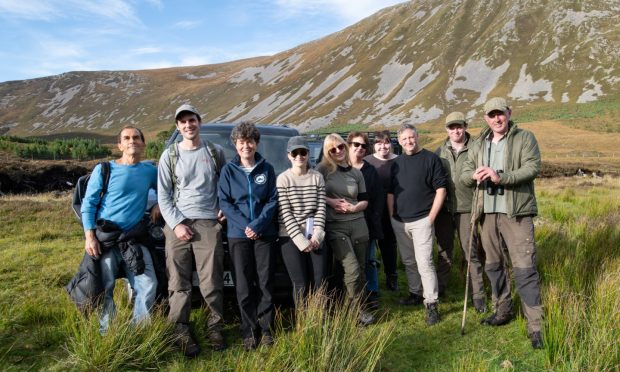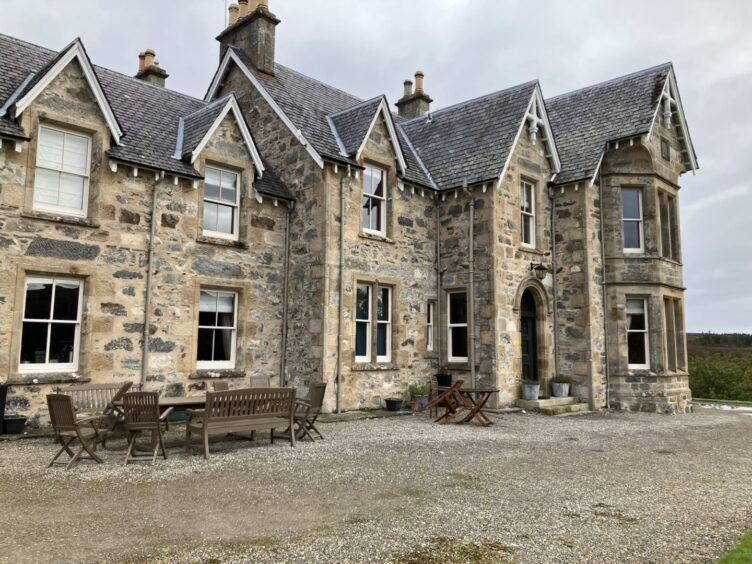Alladale Wilderness Reserve in Sutherland was once a very different place.
Traditionally a sporting estate, Paul Lister bought the land in 2003 with the intention of rewilding and restoring the 23,000 acres.
Over the last two decades, more than a million native trees have been planted, Scottish wildcats have been bred on the estate, and red squirrels have been successfully reintroduced.
The project has been so successful because of the efforts to reduce and control deer numbers.
I was invited by The European Nature Trust and Highland and Islands Environment Foundation to visit Alladale Wilderness Reserve, near Ardgay, to find out for myself what makes it so special.
During our stay Innes MacNeill, reserve manager, and Ryan Munro, chief ranger, took us on a 4×4 tour across the estate.
Read on to find out:
- If predators like lynx could be reintroduced to Alladale
- Why so many trees are being planted, and what this means for the deer
- What other projects are under way at the wilderness reserve
- And how the reserve makes money
Controlling deer gives forests chance to grow and restore
Innes joined Alladale as a deer stalker in 1991, back when it was a very different place.
He tells us he’s been stalking deer since he was a young boy, following generations of his family.
While it took him some time to accept the changes Paul suggested when he first became custodian of the estate, Innes now believes he’s part of a “positive project”.
And as we trundle along in the Land Rover taking in the breathtaking views of the valley, it’s easy to see why.
One of the main focuses of the wilderness reserve is planting more trees to improve the landscape, create a better habitat, and help biodiversity.
According to NatureScot, ancient woodland once covered 70% of Scotland, but now there are only 84 fragments of the Caledonian pinewood left.
The Caledonian pinewood at the Alladale Wilderness Reserve is the second most northerly fragment of this critical habitat.
Through Paul’s vision, and the Estates team’s work, the forest is once again thriving and has even expanded.
As mentioned, more than a million native trees have been planted, including Scots Pine, rowan, willow and juniper. Innes added that some fruit trees have also been planted to “help feed the wildlife of the future”.
In time these trees will self-seed — securing the future of the forest.
But, to achieve this goal and “speed up” the forest restoration, the deer numbers are being controlled.
How much have deer been reduced by?
“We are the only country in Europe without an apex predator,” Innes explained before gesturing at himself and Ryan, “you’re looking at the apex predators here.
“There’s nothing else to manage the deer, so that’s where the problems lie.”
Because of this, deer numbers can grow out of control and the animals can damage and kill young trees, preventing forests from regenerating.
By managing the deer numbers, it gives the trees a chance to seed and grow.
I couldn’t help but ask how much the team had reduced the deer by.
“Quite a lot…” the reserve manager answered.
“We’re probably sitting at around five and a half deer per square kilometre. I guess when I started here, it was probably high 20s, maybe even 30 red deer per square kilometre.
“So yeah, we’ve significantly reduced them — but we haven’t got rid of them.”
Could predators like lynx and wolves make a comeback to Alladale?
While Innes and Ryan control the deer, reintroducing predators is part of Paul’s vision.
“We don’t realistically think reintroducing wolves is going to happen anytime soon,” said Innes, “but a controlled release behind a fence could. And run that experiment for 25 years, just like a wind farm.
“Why wouldn’t you want to experiment and try that and see what it does for the ecology, economy, and education? There’s multiple benefits that could be had.
“And if it doesn’t work, at least we’ll have learned something by trying.”
But for an enclosure big enough to carry out the experiment, which could include two small wolf packs, they would need to have at least 50,000 acres.
The reintroduction of lynx, on the other hand, could be more likely.
Innes said: “The lynx is an ambush predator, so you need more woodland for them, and you would probably never see them.”
Lynx tend to be shy and solitary animals, unlikely to pose a threat to humans. But, they would hunt deer which would bring their numbers under control.
‘We are not getting rid of deer’, says reserve manager
As well as shooting deer, Innes and Ryan use fences to try to stop them from grazing in specific areas.
Fencing off areas helps speed up the recovery, but Innes believes this forest regeneration will also benefit the deer — telling me that the animals historically lived in wooded areas.
He does hope, though, that in the future he will see these fences taken down and deer allowed back into what will be more like their natural habitat.
But he stressed that while they have “significantly reduced” deer numbers, they are not “getting rid of them altogether”, and instead are working to find a better balance.
“Creating these woodlands is about creating a better habitat that will in turn hopefully create better quality deer in the future,” he went on to say.
“I work with the deer. I was brought here as a deer stalker and a lot of my family were deer stalkers.
“I’d never want to come out to the Glen and not be able to see a deer. I think I’d be pretty sad. And when you hear the stags roaring in the Glen during the rutting season, I think that’s a really special thing to witness and be part of.
“Why would we want to remove that?”
Through controlling the deer numbers now and restoring the forests, Innes hopes the work they are doing is improving the health of the deer — and other wildlife that could live in the Highlands.
Highland cows, red squirrels and golden eagles call Alladale home
It’s not just deer that call Alladale and the other surrounding estates home.
A herd of majestic Highland cows roam around the area, grazing, trampling and dunging — leading to plant diversity.
In partnership with the Roy Dennis Wildlife Foundation, 36 squirrels were released at Alladale and some of the neighbouring estates in 2013. The population is now thriving, and spreading far and wide.
I was amazed to hear that golden eagles nest at Alladale, and we visited not long after Roy had been to tag a chick hatched there this year.
While the reserve may already appear to be teeming with wildlife, more animals could eventually be released there — and not just predators.
Once the planted trees grow and the forests expand further, beavers could eventually be released into the Carron catchment.
“We’re probably another 20 years off beaver,” Innes added. “I don’t know if I’ll see them here one day, but who knows? I hope so, they are the ultimate ecosystem engineer.”
Wildcat breeding programme at Alladale
One of our stops included the wildcat enclosures, and I was ecstatic to learn that Alladale is part of the wildcat breeding programme.
The wildcats moved to Alladale in 2011 and Ryan looks after them. He took us down to meet the five cats, but I don’t think they were as impressed by us.
“Wildcats have always had a history up here,” he explained. “They were hunted for their fur and there was a professional wildcat trapper in one of the estates north of here.
“I think Paul just looks at missing things from our landscape. Wildcats are one of them, so it was a case of let’s be part of that programme.”
While they may be the “only cat in the world that can’t be domesticated”, the cats at Alladale are still too used to human contact and will not be released.
However, one of the cats bred here was moved to the Highland Wildlife Park at Kincraig, and her kittens have been released in the Cairngorms.
And while there are no plans to release wildcats in Alladale yet, Ryan is hopeful that one day the felines will freely prowl the area once more.
Connecting people with nature at Alladale
Paul, who inherited the MFI furniture company, uses his own wealth to fund his ambitious conservation plans.
He also founded The European Nature Trust in 2000 to support other conservation projects.
But the money made at Alladale through people staying on the reserve, either in the main Victorian Lodge or one of the cottages, also funds environmental, educational, and conservation projects.
Staying at the reserve gives people the opportunity to fully immerse themselves in nature and experience the wildness around them.
Guests can book their own 4×4 tours for a guided tour of the reserve with the rangers, or take part in other activities like fly-fishing, clay pigeon shooting and mountain biking.
The food served is mostly from the reserve, including the venison and brown trout, making it a real culinary experience.
The team at the reserve also hosts educational visits, inviting hundreds of school children from across the Highlands to visit the reserve and learn more about conservation.
‘Fixing the wrongs’ and creating hope
As we near the end of our tour, Innes stresses that “the past is the past” and it’s time to focus on what we can improve.
He finished: “I’ve been here 33 years now, I’ve been here all my life. I guess I take what we do very personally.
“And we’re lucky that we’ve got someone that continues to invest in the landscape and in projects and improve the asset. Paul is a custodian, a caretaker.
“He’s here for a little window in time, like all of us. And I guess you’ve just got to enjoy it and hope that what we’re doing is the right thing to do.”
If I have taken anything away from my stay at Alladale, it is that there is hope.
Paul and his dedicated team are “making noise for nature”, and pushing the boundaries. I truly believe their efforts are making a difference.
And I hope I get to return one day and see just how much the landscape has changed yet again.
If you would like to visit Alladale, you can find out more online here.






















Conversation